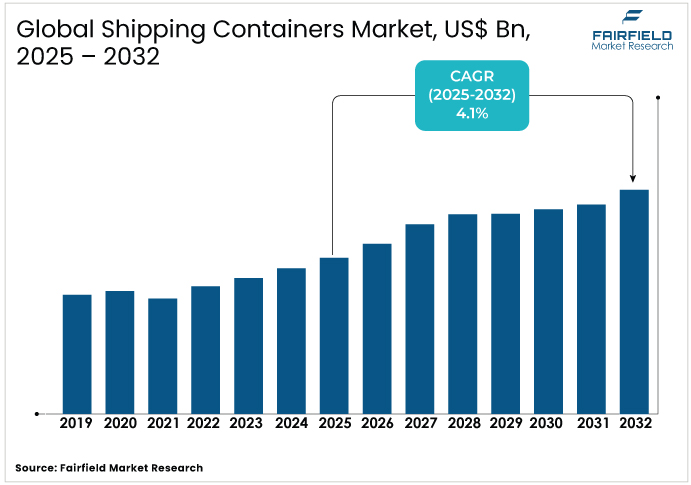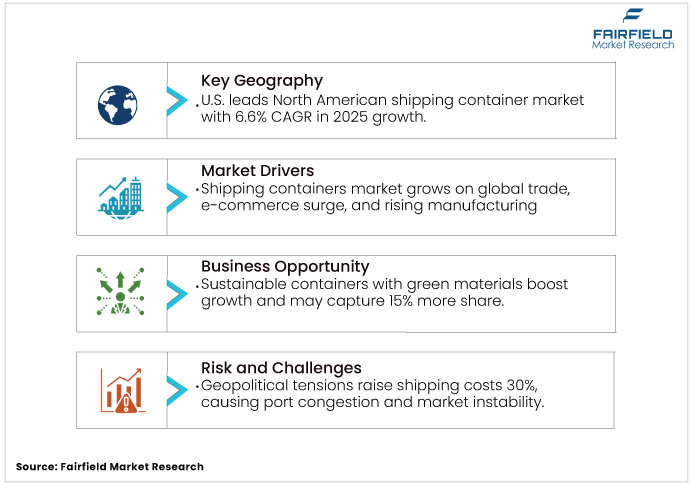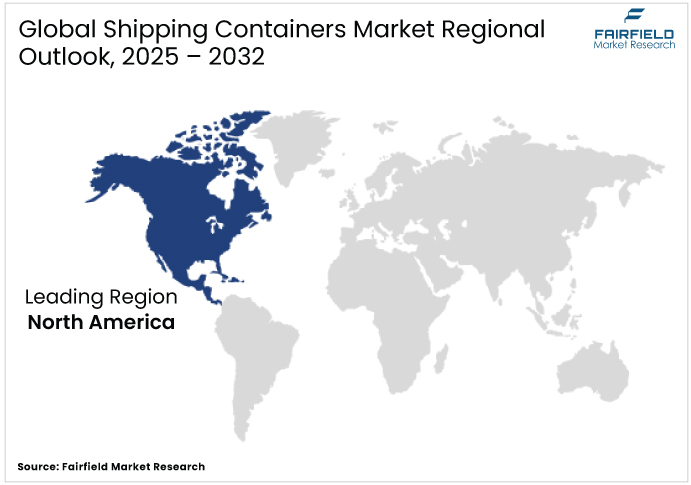Shipping Containers Market Growth and Industry Forecast
- The global shipping containers market is projected to be valued at US$ 9.2 Bn in 2025 and is expected to reach US$ 11.8 Bn by 2032.
- Market is anticipated to grow at a CAGR of 4.1% during the forecast period from 2025 to 2032.

Shipping Containers Market Summary: Key Insights & Trends
- Large containers (40 feet) dominate by size, holding 54.2% market share in 2025 due to their cargo efficiency and cost advantages.
- High cube containers are the fastest-growing size segment, projected to grow at a CAGR of 4.4% driven by demand for high-volume shipments.
- Dry storage containers lead by type, favored for their versatility and cost-effectiveness in transporting non-perishable goods.
- Flat rack containers are the fastest-growing container type, expanding at a CAGR of 4.6% due to increasing demand for oversized cargo transport.
- The healthcare segment is the fastest-growing end-user, expected to grow at a CAGR of 5.1% as demand for refrigerated container transport surges.
- Asia Pacific is the largest regional market, led by China and India, with India growing at a 4.9% CAGR backed by port expansion and e-commerce.
- Rising demand for eco-friendly containers presents a key opportunity, with sustainable solutions potentially boosting market share by 15% by 2032.
A Look Back and a Look Forward - Comparative Analysis
The shipping containers market from 2019 to 2024 experienced dynamic shifts, significantly influenced by global events such as the COVID-19 pandemic. In 2019, the market was growing steadily due to robust maritime trade and increasing demand for efficient logistics solutions. The pandemic in 2020 disrupted supply chains, causing port congestion and container shortages, which spiked freight rates and temporarily stalled growth. However, post-2021 recovery saw a rebound as e-commerce surged and trade agreements expanded, pushing the market by 2024. Investments in automation and sustainable shipping practices further supported recovery, though trade conflicts posed challenges. The Asia Pacific region, particularly China, maintained dominance due to its manufacturing prowess and extensive port infrastructure.
Looking forward from 2025 to 2032, poised for steady growth, the shipping containers market is projected to reach US$ 11.8 bn at a CAGR of 4.1% by 2032. This growth is driven by continued globalization, e-commerce expansion, and technological innovations such as AI-driven logistics and eco-friendly containers. The Asia Pacific region will surely retain its lead, with countries such as India and China investing heavily in port infrastructure. Sustainability pressures will push for greener container designs, while emerging markets in Latin America and Africa offer new opportunities. However, geopolitical tensions and fluctuating raw material costs may pose risks, necessitating strategic adaptations by key players to maintain competitiveness.
Key Growth Drivers
- Rising Global Trade and E-commerce Fuel Demand for Containerized Shipping
The shipping containers market is propelled by the rapid expansion of global trade, with UNCTAD reporting 1,687 million tons of cargo transported annually across 177.6 million containers. The rise of e-commerce, particularly in Asia Pacific and North America, has increased demand for efficient logistics, with online retailers relying on containers for fast and secure delivery. Emerging economies such as India and Brazil, with growing manufacturing sectors, further fuel the need for containerized shipping, driving market growth.
- Digital Innovations such as IoT and AI Drive Smarter Container Logistics Solutions
Innovations such as IoT-enabled containers, blockchain for supply chain transparency, and automated port operations are transforming. These technologies enhance tracking, reduce downtime, and improve efficiency, with 30% of industry players prioritizing digital investments. For instance, AI algorithms optimize trade routes, reducing fuel costs and emissions, which aligns with sustainability goals and boosts market demand.
- Port Infrastructure Investments in Asia Drive Container Handling and Trade Growth
Global investments in port and logistics infrastructure, particularly in China and India, are key drivers. Specifically in the Asia Pacific, rise in mega port construction and expanded terminals increases container handling capacity. These developments facilitate faster cargo movement, supporting the rising volume of seaborne trade and market expansion.

Key Growth Restraints
- Geopolitical Conflicts Disrupt Supply Chains and Elevate Shipping Container Costs
Geopolitical issues, such as the Red Sea Crisis, Tariff wars, and trade disputes, disrupt supply chains and impact. These tensions trigger container imbalances and port congestion, increasing shipping costs by up to 30% in affected regions. Such uncertainties hinder market stability and pose challenges to consistent growth.
- Volatile Steel and Aluminum Prices Challenge Container Production Profitability
The shipping containers market faces challenges from volatile steel and aluminum prices, critical materials for container manufacturing. Price fluctuations increase production costs, reducing profit margins for manufacturers, with some reporting a 30% rise in costs since 2025. This limits scalability and impacts market competitiveness.
Shipping Containers Market Trends and Opportunities
- Eco-Friendly Containers Drive Growth Amid Rising Sustainability and Regulatory Pressures in Shipping Containers Market
The push for sustainability presents opportunities for eco-friendly container designs using recycled materials and alternative energy sources. Companies adopting green practices can attract environmentally conscious clients and comply with stricter regulations, potentially capturing a 15% larger market share by 2032. Therefore, the shipping containers market is poised to witness positive growth driven by the demand ecosystem and the need for business solutions in the industrial packaging industry.
- Latin America and Africa Offer Lucrative Opportunities Through Trade Expansion
Emerging markets in Latin America and Africa offer significant growth potential for the shipping containers industry. With increasing trade activities and infrastructure investments in countries such as Brazil and Nigeria, companies can tap into these regions, potentially boosting market revenue by 10-12% by 2032.

Segment-wise Trends & Analysis
- Large and High Cube Containers Gain Traction for Bulk Trade Efficiency
Large containers (40 feet) lead the shipping containers market, holding a 54.2% share in 2025 due to their economies of scale, allowing 50% more cargo than 20-foot containers. High cube containers (40 feet) are the fastest-growing segment, driven by demand for bulkier shipments in industries such as automotive and consumer goods. Their ability to handle high-volume cargo aligns with global trade efficiency trends, making them increasingly popular.
- Dry and Flat Rack Containers Dominate Due to Versatility and Oversized Cargo
Dry storage containers dominate the shipping containers market, accounting for the largest share in 2024 due to their versatility and cost-effectiveness for non-perishable goods. Flat rack containers are the fastest-growing segment, expected to grow at a CAGR of 4.6%, driven by demand for transporting oversized cargo such as machinery and vehicles, supported by infrastructure development and global trade growth.
- Consumer Goods and Healthcare Sectors Drive Demand for Specialized Containers
The consumer goods segment leads the shipping containers market, driven by e-commerce growth and rising disposable incomes in developing nations such as India and China. The healthcare sector is the fastest-growing end-user, projected to grow at a CAGR of 5.1%, fueled by demand for refrigerated containers to transport temperature-sensitive pharmaceuticals and medical supplies globally.
Regional Trends & Analysis
- North America Leads with Robust Trade, Ports, and Intermodal Infrastructure
The U.S. holds a leading position in the North American shipping container market, with the region expected to grow at a CAGR of 6.6% in 2025. This growth is driven by strong trade partnerships and the presence of major ports such as Los Angeles and Long Beach, which serve as key gateways for international cargo. High consumer demand and well-developed intermodal infrastructure ensure seamless container movement across the region. With a significant share of global container traffic, North America remains a critical hub for efficient, large-scale maritime logistics and transportation solutions.

- Europe Grows with Trade Hubs, Port Investments, and Sustainability Focus
Germany and the U.K. are at the forefront of the European shipping containers market. Germany is projected to grow at a CAGR of 4.2% by 2032, supported by its position as a key trade hub in the region. Significant investments in port infrastructure and increasing maritime trade with Asia are fueling the demand for efficient container handling and logistics solutions. The region’s strong emphasis on environmental sustainability is accelerating the adoption of eco-friendly container solutions. These combined factors position Europe as a growing market, with innovation and green logistics practices driving long-term expansion across major economies.
- Asia Pacific Dominates with Strong Port Network and E-Commerce Expansion
China leads with its expansive port infrastructure and strong manufacturing base, making it a key player in global trade. India is experiencing rapid growth, projected at a CAGR of 4.9%, fueled by the rise of e-commerce and major investments in port modernization. These advancements are boosting container handling capacity and overall operational efficiency. As trade volumes continue to rise, the Asia Pacific holds the largest market share globally, solidifying its position as a central force in international container movement.
Competitive Landscape
The shipping containers market is highly competitive, with key players such as China International Marine Containers (CIMC), Maersk Line, and COSCO Shipping Lines focusing on sustainability, automation, and strategic partnerships to maintain market share. Companies are investing in IoT-enabled containers and eco-friendly designs to meet regulatory demands and customer preferences.
Key Companies
- China International Marine Containers (CIMC)
- Mediterranean Shipping Company (MSC)
- Maersk Line
- CMA CGM Group
- COSCO Shipping Lines
- Hapag-Lloyd
- Triton International
- Textainer
- Singamas Container Holdings
- Seaco Global
- ZIM Integrated Shipping Services
- Evergreen Marine Corporation
- CXIC Group Containers
- Florens Container Services
- Ocean Network Express (ONE)
Recent Industry Developments
- In April 2025, CMA CGM launched a €100 million, five-year partnership with French AI startup Mistral AI to enhance customer service, shipping responsiveness, and media fact‑checking, part of its broader €500 million AI investment plan
- In February 2025, CIMC confirmed its factories are fully booked with container orders through March, boosted by demand following the Red Sea crisis, and projected a 6–8× increase in 2024 net profit to US$340–480 million
- In June 2025, MSC’s ultra-large container vessel, MSC Irina (24,346 TEU), made its maiden call at Vizhinjam, India, demonstrating both MSC’s fleet scale and advancing capability in handling ULCVs
Global Shipping Containers Market Segmentation-
By Container Size
- Small Containers (20 feet)
- Large Containers (40 feet)
- High Cube Containers (40 feet)
By Container Type
- Dry Storage Containers
- Flat Rack Containers
- Refrigerated Containers
- Special Purpose Containers
- Others
By End-User
- Food and Beverages
- Consumer Goods
- Healthcare
- Industrial Products
- Vehicle Transport
- Others
By Region
- North America
- Latin America
- Europe
- Asia Pacific
- The Middle East & Africa
1. Executive Summary
1.1. Global Shipping Containers Market Snapshot
1.2. Future Projections
1.3. Key Market Trends
1.4. Regional Snapshot, by Value, 2025
1.5. Analyst Recommendations
2. Market Overview
2.1. Market Definitions and Segmentations
2.2. Market Dynamics
2.2.1. Drivers
2.2.2. Restraints
2.2.3. Market Opportunities
2.3. Value Chain Analysis
2.4. COVID-19 Impact Analysis
2.5. Porter's Fiver Forces Analysis
2.6. Impact of Russia-Ukraine Conflict
2.7. PESTLE Analysis
2.8. Regulatory Analysis
2.9. Price Trend Analysis
2.9.1. Current Prices and Future Projections, 2024-2032
2.9.2. Price Impact Factors
3. Global Shipping Containers Market Outlook, 2019 - 2032
3.1. Global Shipping Containers Market Outlook, by Container Size, Value (US$ Bn), 2019-2032
3.1.1. Small Containers (20 feet)
3.1.2. Large Containers (40 feet)
3.1.3. High Cube Containers (40 feet)
3.2. Global Shipping Containers Market Outlook, by Container Type, Value (US$ Bn), 2019-2032
3.2.1. Dry Storage Containers
3.2.2. Flat Rack Containers
3.2.3. Refrigerated Containers
3.2.4. Special Purpose Containers
3.2.5. Others
3.3. Global Shipping Containers Market Outlook, by End-User, Value (US$ Bn), 2019-2032
3.3.1. Food and Beverages
3.3.2. Consumer Goods
3.3.3. Healthcare
3.3.4. Industrial Products
3.3.5. Vehicle Transport
3.3.6. Others
3.4. Global Shipping Containers Market Outlook, by Region, Value (US$ Bn), 2019-2032
3.4.1. North America
3.4.2. Europe
3.4.3. Asia Pacific
3.4.4. Latin America
3.4.5. Middle East & Africa
4. North America Shipping Containers Market Outlook, 2019 - 2032
4.1. North America Shipping Containers Market Outlook, by Container Size, Value (US$ Bn), 2019-2032
4.1.1. Small Containers (20 feet)
4.1.2. Large Containers (40 feet)
4.1.3. High Cube Containers (40 feet)
4.2. North America Shipping Containers Market Outlook, by Container Type, Value (US$ Bn), 2019-2032
4.2.1. Dry Storage Containers
4.2.2. Flat Rack Containers
4.2.3. Refrigerated Containers
4.2.4. Special Purpose Containers
4.2.5. Others
4.3. North America Shipping Containers Market Outlook, by End-User, Value (US$ Bn), 2019-2032
4.3.1. Food and Beverages
4.3.2. Consumer Goods
4.3.3. Healthcare
4.3.4. Industrial Products
4.3.5. Vehicle Transport
4.3.6. Others
4.4. North America Shipping Containers Market Outlook, by Country, Value (US$ Bn), 2019-2032
4.4.1. U.S. Shipping Containers Market Outlook, by Container Size, 2019-2032
4.4.2. U.S. Shipping Containers Market Outlook, by Container Type, 2019-2032
4.4.3. U.S. Shipping Containers Market Outlook, by End-User, 2019-2032
4.4.4. Canada Shipping Containers Market Outlook, by Container Size, 2019-2032
4.4.5. Canada Shipping Containers Market Outlook, by Container Type, 2019-2032
4.4.6. Canada Shipping Containers Market Outlook, by End-User, 2019-2032
4.5. BPS Analysis/Market Attractiveness Analysis
5. Europe Shipping Containers Market Outlook, 2019 - 2032
5.1. Europe Shipping Containers Market Outlook, by Container Size, Value (US$ Bn), 2019-2032
5.1.1. Small Containers (20 feet)
5.1.2. Large Containers (40 feet)
5.1.3. High Cube Containers (40 feet)
5.2. Europe Shipping Containers Market Outlook, by Container Type, Value (US$ Bn), 2019-2032
5.2.1. Dry Storage Containers
5.2.2. Flat Rack Containers
5.2.3. Refrigerated Containers
5.2.4. Special Purpose Containers
5.2.5. Others
5.3. Europe Shipping Containers Market Outlook, by End-User, Value (US$ Bn), 2019-2032
5.3.1. Food and Beverages
5.3.2. Consumer Goods
5.3.3. Healthcare
5.3.4. Industrial Products
5.3.5. Vehicle Transport
5.3.6. Others
5.4. Europe Shipping Containers Market Outlook, by Country, Value (US$ Bn), 2019-2032
5.4.1. Germany Shipping Containers Market Outlook, by Container Size, 2019-2032
5.4.2. Germany Shipping Containers Market Outlook, by Container Type, 2019-2032
5.4.3. Germany Shipping Containers Market Outlook, by End-User, 2019-2032
5.4.4. Italy Shipping Containers Market Outlook, by Container Size, 2019-2032
5.4.5. Italy Shipping Containers Market Outlook, by Container Type, 2019-2032
5.4.6. Italy Shipping Containers Market Outlook, by End-User, 2019-2032
5.4.7. France Shipping Containers Market Outlook, by Container Size, 2019-2032
5.4.8. France Shipping Containers Market Outlook, by Container Type, 2019-2032
5.4.9. France Shipping Containers Market Outlook, by End-User, 2019-2032
5.4.10. U.K. Shipping Containers Market Outlook, by Container Size, 2019-2032
5.4.11. U.K. Shipping Containers Market Outlook, by Container Type, 2019-2032
5.4.12. U.K. Shipping Containers Market Outlook, by End-User, 2019-2032
5.4.13. Spain Shipping Containers Market Outlook, by Container Size, 2019-2032
5.4.14. Spain Shipping Containers Market Outlook, by Container Type, 2019-2032
5.4.15. Spain Shipping Containers Market Outlook, by End-User, 2019-2032
5.4.16. Russia Shipping Containers Market Outlook, by Container Size, 2019-2032
5.4.17. Russia Shipping Containers Market Outlook, by Container Type, 2019-2032
5.4.18. Russia Shipping Containers Market Outlook, by End-User, 2019-2032
5.4.19. Rest of Europe Shipping Containers Market Outlook, by Container Size, 2019-2032
5.4.20. Rest of Europe Shipping Containers Market Outlook, by Container Type, 2019-2032
5.4.21. Rest of Europe Shipping Containers Market Outlook, by End-User, 2019-2032
5.5. BPS Analysis/Market Attractiveness Analysis
6. Asia Pacific Shipping Containers Market Outlook, 2019 - 2032
6.1. Asia Pacific Shipping Containers Market Outlook, by Container Size, Value (US$ Bn), 2019-2032
6.1.1. Small Containers (20 feet)
6.1.2. Large Containers (40 feet)
6.1.3. High Cube Containers (40 feet)
6.2. Asia Pacific Shipping Containers Market Outlook, by Container Type, Value (US$ Bn), 2019-2032
6.2.1. Dry Storage Containers
6.2.2. Flat Rack Containers
6.2.3. Refrigerated Containers
6.2.4. Special Purpose Containers
6.2.5. Others
6.3. Asia Pacific Shipping Containers Market Outlook, by End-User, Value (US$ Bn), 2019-2032
6.3.1. Food and Beverages
6.3.2. Consumer Goods
6.3.3. Healthcare
6.3.4. Industrial Products
6.3.5. Vehicle Transport
6.3.6. Others
6.4. Asia Pacific Shipping Containers Market Outlook, by Country, Value (US$ Bn), 2019-2032
6.4.1. China Shipping Containers Market Outlook, by Container Size, 2019-2032
6.4.2. China Shipping Containers Market Outlook, by Container Type, 2019-2032
6.4.3. China Shipping Containers Market Outlook, by End-User, 2019-2032
6.4.4. Japan Shipping Containers Market Outlook, by Container Size, 2019-2032
6.4.5. Japan Shipping Containers Market Outlook, by Container Type, 2019-2032
6.4.6. Japan Shipping Containers Market Outlook, by End-User, 2019-2032
6.4.7. South Korea Shipping Containers Market Outlook, by Container Size, 2019-2032
6.4.8. South Korea Shipping Containers Market Outlook, by Container Type, 2019-2032
6.4.9. South Korea Shipping Containers Market Outlook, by End-User, 2019-2032
6.4.10. India Shipping Containers Market Outlook, by Container Size, 2019-2032
6.4.11. India Shipping Containers Market Outlook, by Container Type, 2019-2032
6.4.12. India Shipping Containers Market Outlook, by End-User, 2019-2032
6.4.13. Southeast Asia Shipping Containers Market Outlook, by Container Size, 2019-2032
6.4.14. Southeast Asia Shipping Containers Market Outlook, by Container Type, 2019-2032
6.4.15. Southeast Asia Shipping Containers Market Outlook, by End-User, 2019-2032
6.4.16. Rest of SAO Shipping Containers Market Outlook, by Container Size, 2019-2032
6.4.17. Rest of SAO Shipping Containers Market Outlook, by Container Type, 2019-2032
6.4.18. Rest of SAO Shipping Containers Market Outlook, by End-User, 2019-2032
6.5. BPS Analysis/Market Attractiveness Analysis
7. Latin America Shipping Containers Market Outlook, 2019 - 2032
7.1. Latin America Shipping Containers Market Outlook, by Container Size, Value (US$ Bn), 2019-2032
7.1.1. Small Containers (20 feet)
7.1.2. Large Containers (40 feet)
7.1.3. High Cube Containers (40 feet)
7.2. Latin America Shipping Containers Market Outlook, by Container Type, Value (US$ Bn), 2019-2032
7.2.1. Dry Storage Containers
7.2.2. Flat Rack Containers
7.2.3. Refrigerated Containers
7.2.4. Special Purpose Containers
7.2.5. Others
7.3. Latin America Shipping Containers Market Outlook, by End-User, Value (US$ Bn), 2019-2032
7.3.1. Food and Beverages
7.3.2. Consumer Goods
7.3.3. Healthcare
7.3.4. Industrial Products
7.3.5. Vehicle Transport
7.3.6. Others
7.4. Latin America Shipping Containers Market Outlook, by Country, Value (US$ Bn), 2019-2032
7.4.1. Brazil Shipping Containers Market Outlook, by Container Size, 2019-2032
7.4.2. Brazil Shipping Containers Market Outlook, by Container Type, 2019-2032
7.4.3. Brazil Shipping Containers Market Outlook, by End-User, 2019-2032
7.4.4. Mexico Shipping Containers Market Outlook, by Container Size, 2019-2032
7.4.5. Mexico Shipping Containers Market Outlook, by Container Type, 2019-2032
7.4.6. Mexico Shipping Containers Market Outlook, by End-User, 2019-2032
7.4.7. Argentina Shipping Containers Market Outlook, by Container Size, 2019-2032
7.4.8. Argentina Shipping Containers Market Outlook, by Container Type, 2019-2032
7.4.9. Argentina Shipping Containers Market Outlook, by End-User, 2019-2032
7.4.10. Rest of LATAM Shipping Containers Market Outlook, by Container Size, 2019-2032
7.4.11. Rest of LATAM Shipping Containers Market Outlook, by Container Type, 2019-2032
7.4.12. Rest of LATAM Shipping Containers Market Outlook, by End-User, 2019-2032
7.5. BPS Analysis/Market Attractiveness Analysis
8. Middle East & Africa Shipping Containers Market Outlook, 2019 - 2032
8.1. Middle East & Africa Shipping Containers Market Outlook, by Container Size, Value (US$ Bn), 2019-2032
8.1.1. Small Containers (20 feet)
8.1.2. Large Containers (40 feet)
8.1.3. High Cube Containers (40 feet)
8.2. Middle East & Africa Shipping Containers Market Outlook, by Container Type, Value (US$ Bn), 2019-2032
8.2.1. Dry Storage Containers
8.2.2. Flat Rack Containers
8.2.3. Refrigerated Containers
8.2.4. Special Purpose Containers
8.2.5. Others
8.3. Middle East & Africa Shipping Containers Market Outlook, by End-User, Value (US$ Bn), 2019-2032
8.3.1. Food and Beverages
8.3.2. Consumer Goods
8.3.3. Healthcare
8.3.4. Industrial Products
8.3.5. Vehicle Transport
8.3.6. Others
8.4. Middle East & Africa Shipping Containers Market Outlook, by Country, Value (US$ Bn), 2019-2032
8.4.1. GCC Shipping Containers Market Outlook, by Container Size, 2019-2032
8.4.2. GCC Shipping Containers Market Outlook, by Container Type, 2019-2032
8.4.3. GCC Shipping Containers Market Outlook, by End-User, 2019-2032
8.4.4. South Africa Shipping Containers Market Outlook, by Container Size, 2019-2032
8.4.5. South Africa Shipping Containers Market Outlook, by Container Type, 2019-2032
8.4.6. South Africa Shipping Containers Market Outlook, by End-User, 2019-2032
8.4.7. Egypt Shipping Containers Market Outlook, by Container Size, 2019-2032
8.4.8. Egypt Shipping Containers Market Outlook, by Container Type, 2019-2032
8.4.9. Egypt Shipping Containers Market Outlook, by End-User, 2019-2032
8.4.10. Nigeria Shipping Containers Market Outlook, by Container Size, 2019-2032
8.4.11. Nigeria Shipping Containers Market Outlook, by Container Type, 2019-2032
8.4.12. Nigeria Shipping Containers Market Outlook, by End-User, 2019-2032
8.4.13. Rest of Middle East Shipping Containers Market Outlook, by Container Size, 2019-2032
8.4.14. Rest of Middle East Shipping Containers Market Outlook, by Container Type, 2019-2032
8.4.15. Rest of Middle East Shipping Containers Market Outlook, by End-User, 2019-2032
8.5. BPS Analysis/Market Attractiveness Analysis
9. Competitive Landscape
9.1. Company Vs Segment Heatmap
9.2. Company Market Share Analysis, 2024
9.3. Competitive Dashboard
9.4. Company Profiles
9.4.1. China International Marine Containers (CIMC)
9.4.1.1. Company Overview
9.4.1.2. Product Portfolio
9.4.1.3. Financial Overview
9.4.1.4. Business Strategies and Developments
9.4.2. Mediterranean Shipping Company (MSC)
9.4.2.1. Company Overview
9.4.2.2. Product Portfolio
9.4.2.3. Financial Overview
9.4.2.4. Business Strategies and Developments
9.4.3. Maersk Line
9.4.3.1. Company Overview
9.4.3.2. Product Portfolio
9.4.3.3. Financial Overview
9.4.3.4. Business Strategies and Developments
9.4.4. CMA CGM Group
9.4.4.1. Company Overview
9.4.4.2. Product Portfolio
9.4.4.3. Financial Overview
9.4.4.4. Business Strategies and Developments
9.4.5. COSCO Shipping Lines
9.4.5.1. Company Overview
9.4.5.2. Product Portfolio
9.4.5.3. Financial Overview
9.4.5.4. Business Strategies and Developments
9.4.6. Hapag-Lloyd
9.4.6.1. Company Overview
9.4.6.2. Product Portfolio
9.4.6.3. Financial Overview
9.4.6.4. Business Strategies and Developments
9.4.7. Triton International
9.4.7.1. Company Overview
9.4.7.2. Product Portfolio
9.4.7.3. Financial Overview
9.4.7.4. Business Strategies and Developments
9.4.8. Textainer
9.4.8.1. Company Overview
9.4.8.2. Product Portfolio
9.4.8.3. Financial Overview
9.4.8.4. Business Strategies and Developments
9.4.9. Singamas Container Holdings
9.4.9.1. Company Overview
9.4.9.2. Product Portfolio
9.4.9.3. Financial Overview
9.4.9.4. Business Strategies and Developments
9.4.10. Seaco Global
9.4.10.1. Company Overview
9.4.10.2. Product Portfolio
9.4.10.3. Financial Overview
9.4.10.4. Business Strategies and Developments
10. Appendix
10.1. Research Methodology
10.2. Report Assumptions
10.3. Acronyms and Abbreviations
|
BASE YEAR |
HISTORICAL DATA |
FORECAST PERIOD |
UNITS |
|||
|
2024 |
|
2019 - 2024 |
2025 - 2032 |
Value: US$ Billion |
||
|
REPORT FEATURES |
DETAILS |
|
Container Size Coverage |
|
|
Container Type Coverage |
|
|
End-User Coverage |
|
|
Geographical Coverage |
|
|
Leading Companies |
|
|
Report Highlights |
Key Market Indicators, Macro-micro economic impact analysis, Technological Roadmap, Key Trends, Driver, Restraints, and Future Opportunities & Revenue Pockets, Porter’s 5 Forces Analysis, Historical Trend (2019-2024), Market Estimates and Forecast, Market Dynamics, Industry Trends, Competition Landscape, Category, Region, Country-wise Trends & Analysis, COVID-19 Impact Analysis (Demand and Supply Chain) |
